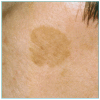980 nm diode lasers in oral and facial practice: current state of the science and art
- PMID: 19960121
- PMCID: PMC2786991
- DOI: 10.7150/ijms.6.358
980 nm diode lasers in oral and facial practice: current state of the science and art
Abstract
Aim: To evaluate the safety and efficacy of a 980 nm diode laser for the treatment of benign facial pigmented and vascular lesions, and in oral surgery.
Materials and methods: 20 patients were treated with a 980 nm diode laser. Oral surgery: 5 patients (5 upper and lower frenulectomy). Fluence levels were 5-15 J/cm(2); pulse lengths were 20-60 ms; spot size was 1 mm. Vascular lesions: 10 patients (5 small angiomas, 5 telangiectases). Fluences were 6-10 J/cm(2); pulse lengths were 10-50 ms; spot size was 2 mm. In all cases the areas surrounding the lesions were cooled. Pigmented lesions: 5 patients (5 keratoses). All the lesions were evaluated by dermatoscopy before the treatment. Fluence levels were 7-15 J/cm(2); pulse lengths were 20-50 ms; spot size was 1 mm. All the patients were followed at 1, 4 and 8 weeks after the procedure.
Results: Healing in oral surgery was within 10 days. The melanoses healed completely within four weeks. All the vascular lesions healed after 15 days without any residual scarring.
Conclusions: The end results for the use of the 980 nm diode laser in oral and facial surgery appears to be justified on the grounds of efficacy and safety of the device, and good degree of acceptance by the patients, without compromising their health and function.
Keywords: 980 nm Diode Laser; frenulectomy.; pigmented lesions; vascular lesions.
Conflict of interest statement
Conflict of Interest: The authors have declared that no conflict of interest exists.
Figures









References
-
- Tan T, Morelli J.G, Kurban A.K. Pulsed dye laser treatment of the benign cutaneous pigmented lesions. Laser Surg. Med. 1992;12:538. - PubMed
-
- McCoy SE. Copper Bromide Laser Treatment of Facial Telangiectasia: Results of Patients Treated Over Five Years. Laser in Surg. Med. 1997;21:329–340. - PubMed
-
- Anderson RR, Parrish JA. Selective photothermolysis: precise microsurgery by selective absorption of pulsed radiation. Science. 1983;220:524–527. - PubMed
-
- Goldberg DJ. Laser Dermatology. Berlin Heidelberg: Springer; 2005. Laser Treatment of Vascular Lesions; pp. 13–35.
-
- van Gemert MJ, Welch AJ, Pickering JW, Tan OT, Gijsbers GH. Wavelengths for laser treatment of port wine stains and telangiectasia. Lasers Surg Med. 1995;16(2):147–55. - PubMed
Publication types
MeSH terms
LinkOut - more resources
Full Text Sources
Medical

